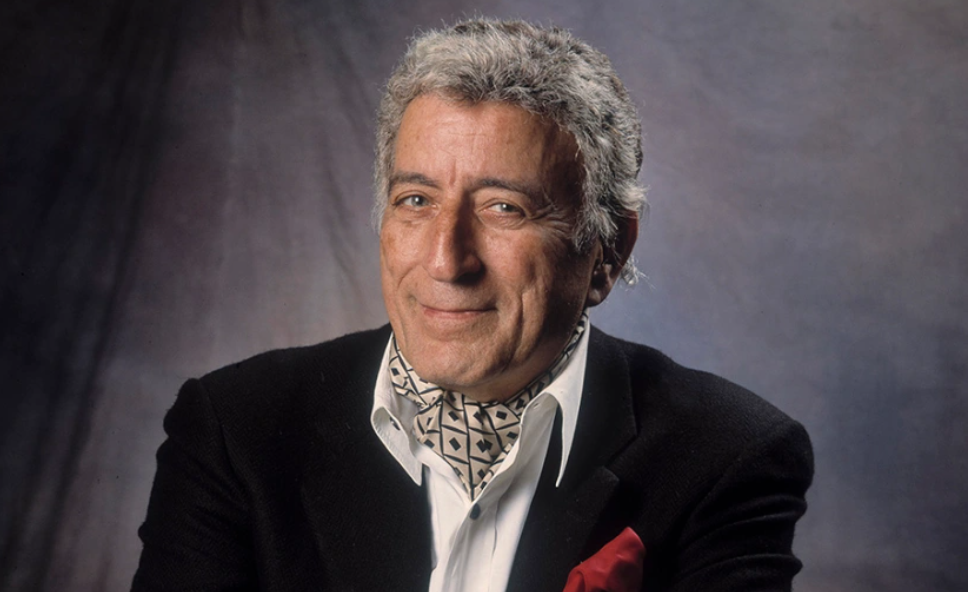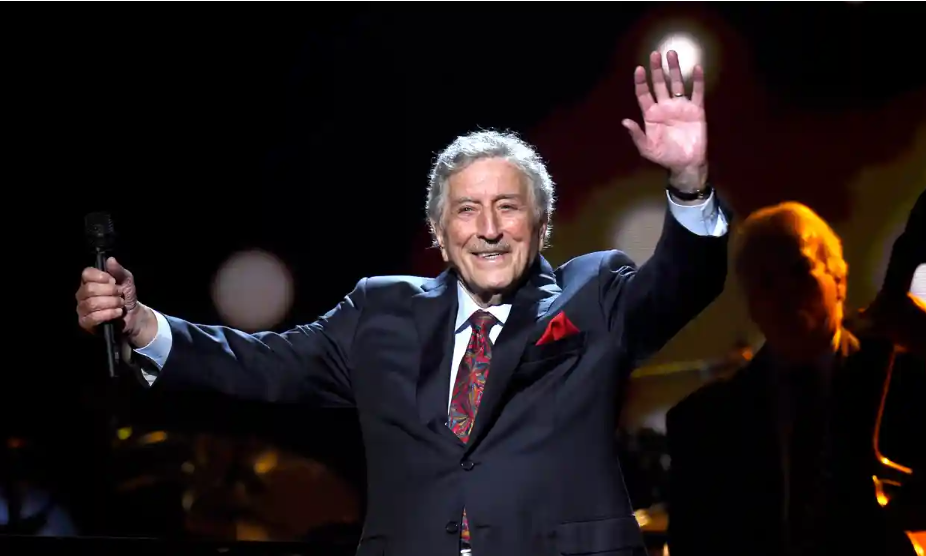Tony, the master pop vocalist who had a professional career spanning eight decades with a No. 1 album at age 85, died on Friday morning in New York City. He was 96.
Tony Bennett
Bennett was diagnosed with Alzheimer’s disease in 2016, but had continued to perform and record through 2021.
His peer Frank Sinatra called him the greatest popular singer in the world. His recordings – most of them made for Columbia Records, which signed him in 1950 – were characterized by ebullience, immense warmth, vocal clarity and emotional openness. A gifted and technically accomplished interpreter of the Great American Songbook, he may be best known for his signature 1962 hit “I Left My Heart in San Francisco.”
He was equally at home in front of intimate combos (which often featured his pianist and longtime musical director Ralph Sharon) and lushly arranged orchestras. Though never strictly a jazz singer, he flourished in jazz settings, and cut memorable sessions with Count Basie’s big band and the lyrical pianist Bill Evans.
Active as a recording artist since 1949, and one of the top pop performers in the ’50s and early ’60s, Bennett saw his career surge anew in the ’90s and again in the new millennium, under the management of his son Danny.
In later years, he memorably dueted on the standard “Body and Soul” with Amy Winehouse, and released a full-length duet album with Diana Krall and a pair of recordings with Lady Gaga. Even after the revelation in early 2021 that he had been diagnosed with Alzheimer’s, he remained active.
His last public appearance came with Gaga at Radio City Music Hall in August 2021, two months before his last release, the Bennett-Gaga set “Love for Sale,” the sequel to their chart-topping 2014 collaboration “Cheek to Cheek.”
After gaining a young new audience with smartly booked TV appearances, his “MTV Unplugged” album of 1994 — released when Bennett was 67 — won a Grammy as album of the year. A pair of “Duets” albums in 2006 and 2011 enlisted new fans; the latter release reached the apex of the U.S. charts.
Pondering Bennett’s unprecedented artistic longevity and enduring popularity in “A Biographical Guide to the Great Jazz and Pop Singers,” critic Will Friedwald wrote, “The idea that someone who sang the great show tunes of the Eisenhower era and earlier could compete with heavy metal and rap would have previously seemed fodder for one of those rapidly aging comics who opened for Sinatra.”
Winner of 18 Grammy Awards (with 36 total nominations), and a Recording Academy Lifetime Achievement Award recipient in 2001, Bennett also garnered two Emmy Awards. He was a Kennedy Center Honoree in 2005 and a National Endowment for the Arts Jazz Master in 2006.
The source of Bennett’s generation-hopping appeal may be best summed up in an observation about his singing by composer and critic Alec Wilder: “There is a quality about it that lets you in.”
He was born Anthony Dominick Benedetto in Astoria, Queens, New York on Aug. 3, 1926, to Italian immigrant parents; his father was a grocer, his mother a seamstress. Raised in poverty, he began singing as a child, and studied music and his other lifelong love, painting, at New York’s High School of Industrial Art. His vocal influences included Al Jolson, Bing Crosby and, later, Frank Sinatra, as well as such female singers as Billie Holiday and Judy Garland.

Drafted at 18 in 1944, he served in World War II’s European theater, doing combat infantry duty and liberating a German concentration camp. After the end of the conflict, he sang as a member of an Armed Forces band.
On his return from service, he studied voice with Miriam Spier in the American Theater Wing. He cut his first, unsuccessful sides for independent Leslie Records in 1949, as “Joe Bari.”
A series of breaks raised his professional profile. An appearance on Arthur Godfrey’s talent show (where he placed second to Rosemary Clooney) led to a 1949 TV shot on Jan Murray’s “Songs for Sale.”
On the strength of that appearance, songstress Pearl Bailey hired him as a club opener, and Bob Hope was in the Greenwich Village venue to catch the performance. Taking the youthful vocalist under his wing, Hope rechristened him Tony Bennett (an abbreviation and Americanization of his given name) and hired him for his stage show at New York’s Paramount Theatre.
In 1950, Bennett submitted a demo of Harry Warren’s “Boulevard of Broken Dreams” to Columbia Records’ head of A&R Mitch Miller, who signed him to the label and encouraged him to develop his own style.
A remake of “Boulevard” was succeeded by a trio of No. 1 pop singles: “Because of You” (1951), a recasting of Hank Williams’ country hit “Cold, Cold Heart” (1951) and the exuberant “Rags to Riches” (1953). The latter number was memorably used under the opening credits of Martin Scorsese’s 1990 gangster epic “Goodfellas.”
Bennett was a reliable if not top-flight hitmaker at Columbia during the ’50s. He cut several noteworthy albums, including “The Beat of My Heart” (1957), a percussive, jazz-inflected set featuring drummers Art Blakey, Chico Hamilton and Jo Jones; “Strike Up the Band” and “In Person!” (both 1959), groundbreaking collaborations with the Count Basie Orchestra; and “Tony Sings for Two” (1961), an intimate duo recital with pianist Sharon, who joined Bennett as musical director in 1957.
It was Sharon who brought “I Left My Heart in San Francisco,” penned by his friends George Cory and Douglas Cross, to Bennett’s concert book. Debuted during a December 1961 date at the Venetian Room of San Francisco’s Fairmont Hotel, the number was issued as the B-side of “Once Upon a Time” in 1962. DJs began spinning the flip side, and though the song climbed no higher than No. 19 on the singles chart, it pushed its like-titled album to No. 5 nationally. Bennett won his first Grammys with the song, reaping records of the year and best male solo vocal performance.
A landmark 1962 concert at Carnegie Hall with Sharon’s trio was followed in 1963 by the top 20 hits “I Wanna Be Around” and “The Good Life.” But the ascent of rock on the charts shook Bennett’s career; he was further unmoored when Sharon exited his employ in 1965, and he bridled at Columbia’s attempts to “contemporize” his sound. After some misbegotten albums and a run of singles that barely scraped the lower reaches of the charts, Bennett split with the label in 1971.
Following a brief and unproductive association with MGM Records, Bennett started his own label, Improv. During this period, he cut a much-admired two-LP set of Rodgers & Hart songs and two celebrated duo albums with Bill Evans, both classics of vocal art. But, lacking proper distribution, Improv founded in 1977.
Without a label or manager, embroiled in a nasty divorce from his second wife, hounded by the IRS and grappling with a near-fatal cocaine addiction, Bennett was at a personal low when Danny Bennett assumed management of his father’s career in 1980.
A renaissance ensued. Booked by his son on such hip TV enterprises as “The David Letterman Show” and the MTV Video Music Awards (with the Red Hot Chili Peppers), Bennett attained a fresh audience that was at best dimly aware of his earlier work. Returning to Columbia Records, he inaugurated a singular series of concept albums and renewed his work with Ralph Sharon. The widely admired album “The Art of Excellence” (1986) returned him to the charts.
He secured his resurgent reputation with the Grammy-winning “Perfectly Frank” (1992) and “Steppin’ Out” (1993), tributes to Sinatra and Fred Astaire, respectively. A hip-hop themed video for the latter album’s title cut prefaced his triumphant “MTV Unplugged” special and album.
Bennett maintained his pace as a perennial Grammy winner in the traditional pop vocal category through the ’90s and into the new millennium, with popular albums devoted to female vocalists, Billie Holiday, Duke Ellington and the blues. He waxed a Grammy-winning duet set, “A Wonderful World,” with K.D. Lang in 2002. He reunited with the Basie band in 2008 for “A Swingin’ Christmas.”
As his musical career continued its autumnal upswing, Bennett’s profile as a painter also rose. He counted artist David Hockney among his admirers and close friends. His work was exhibited in galleries internationally, and his rendering of New York’s Central Park hangs in the Smithsonian American Art Museum in Washington, D.C. He published books about his art in 1996 and 2007. (An autobiography, “The Good Life,” written with Will Friedwald, was issued in 1998.)
Bennett collected primetime Emmys for his recitals “Live by Request” (1996) and “An American Classic” (2007). He dipped his toe into acting with appearances on the ’60s detective show “77 Sunset Strip” and a featured role in “The Oscar” (1966).
Though his gleaming, soaring tenor darkened into a burnished, grainy baritone in the later years of his career, Bennett never lost his interpretive skills. Nowhere was his continuing agility demonstrated more ably than on his two “Duets” collections, which challengingly paired him with a panoply of much younger stars. The second collection hit the top of the charts with a 179,000-copy debut week in September 2011, making Bennett the oldest performer in history to release a No. 1 album.
He is survived by his wife Susan Benedetto, his two sons, Danny and Dae Bennett, his daughters Johanna Bennett and Antonia Bennett, and nine grandchildren.





